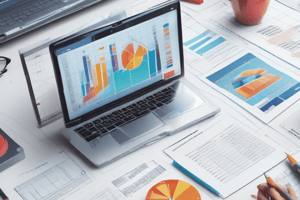Podcast
Questions and Answers
What is the primary purpose of a financial plan in a business?
What is the primary purpose of a financial plan in a business?
- To detail the operational logistics and supply chain management.
- To describe the company's organizational structure and human resources policies.
- To outline the marketing strategies of the business.
- To express the business plan in monetary terms, including budgets, financing, and risk assessment. (correct)
A financial plan is only useful for securing external financing and has no bearing on internal management decisions.
A financial plan is only useful for securing external financing and has no bearing on internal management decisions.
False (B)
Name three components typically included in a comprehensive financial plan.
Name three components typically included in a comprehensive financial plan.
Cash budgets, financing section, and risk assessment
The financial plan expresses all the components of your business plan in measurable units of ________.
The financial plan expresses all the components of your business plan in measurable units of ________.
What was the key challenge Ms. Yong Suk Daley faced before developing a proper business plan?
What was the key challenge Ms. Yong Suk Daley faced before developing a proper business plan?
Ms. Yong Suk Daley's clothing-alteration shop saw immediate success after her 2006 renovation.
Ms. Yong Suk Daley's clothing-alteration shop saw immediate success after her 2006 renovation.
What specific type of budget did Ms. Yong Suk Daley prepare as part of her loan application?
What specific type of budget did Ms. Yong Suk Daley prepare as part of her loan application?
Match each component of a financial plan to its primary purpose:
Match each component of a financial plan to its primary purpose:
What is the primary purpose of a financial plan?
What is the primary purpose of a financial plan?
Fixed costs vary directly with the number of units sold.
Fixed costs vary directly with the number of units sold.
What two types of costs are cash outflows sorted into?
What two types of costs are cash outflows sorted into?
The forecast value of your business at the end of a specified period is known as the ______.
The forecast value of your business at the end of a specified period is known as the ______.
Match the component of the financial plan to its description:
Match the component of the financial plan to its description:
Which of the following factors should be considered when determining the time frame for a cash budget?
Which of the following factors should be considered when determining the time frame for a cash budget?
Raw materials are typically classified as fixed costs because their expense remains constant regardless of production volume.
Raw materials are typically classified as fixed costs because their expense remains constant regardless of production volume.
In the initial years of a new business, how do negative net cash flows typically impact the ending cash balance without external funding?
In the initial years of a new business, how do negative net cash flows typically impact the ending cash balance without external funding?
Which financial metric indicates the time it takes for an investment to generate enough cash flow to cover the initial cost?
Which financial metric indicates the time it takes for an investment to generate enough cash flow to cover the initial cost?
Fixed costs are costs that fluctuate directly with the number of units sold.
Fixed costs are costs that fluctuate directly with the number of units sold.
What is the term for forecasts that are created by altering one or more variables from the original forecast to assess potential impacts on financial outcomes?
What is the term for forecasts that are created by altering one or more variables from the original forecast to assess potential impacts on financial outcomes?
The minimum amount of cash a business requires for its day-to-day operations is known as the __________.
The minimum amount of cash a business requires for its day-to-day operations is known as the __________.
Match the following financial terms with their descriptions:
Match the following financial terms with their descriptions:
What does a positive Net Present Value (NPV) indicate about a business venture?
What does a positive Net Present Value (NPV) indicate about a business venture?
Variable costs are typically expressed as what in relation to sales?
Variable costs are typically expressed as what in relation to sales?
A longer payback period generally indicates a more attractive business investment.
A longer payback period generally indicates a more attractive business investment.
Flashcards
Financial Plan
Financial Plan
A business plan expressed in monetary terms, including cash budgets, financing needs, and risk/reward assessments.
Purpose of a Financial Plan
Purpose of a Financial Plan
The financial plan puts all plans into measurable monetary units.
Cash Budget
Cash Budget
A forecast of cash inflows and outflows over a specific period.
Cash Inflows
Cash Inflows
Signup and view all the flashcards
Cash Outflows
Cash Outflows
Signup and view all the flashcards
Financing Section
Financing Section
Signup and view all the flashcards
Measuring Risks
Measuring Risks
Signup and view all the flashcards
Required Rate of Return
Required Rate of Return
Signup and view all the flashcards
Goals of a Financial Plan
Goals of a Financial Plan
Signup and view all the flashcards
Financial Plan Components
Financial Plan Components
Signup and view all the flashcards
Variable Costs
Variable Costs
Signup and view all the flashcards
Examples of Variable Costs
Examples of Variable Costs
Signup and view all the flashcards
Fixed Costs
Fixed Costs
Signup and view all the flashcards
Terminal Value
Terminal Value
Signup and view all the flashcards
Minimum Operating Cash
Minimum Operating Cash
Signup and view all the flashcards
Payback Period
Payback Period
Signup and view all the flashcards
Internal Rate of Return (IRR)
Internal Rate of Return (IRR)
Signup and view all the flashcards
Net Present Value (NPV)
Net Present Value (NPV)
Signup and view all the flashcards
Breakeven Point
Breakeven Point
Signup and view all the flashcards
Sensitivities
Sensitivities
Signup and view all the flashcards
Study Notes
The Financial Plan
- Chapter 8 focuses on financial risks: how to measure and express them
- Risk is related to the rewards of a business
- A business can be evaluated to determine if it is "worth the risk" or "worth the trouble"
Story From Real Life
- Ms. Yong Suk Daley opened a clothing-alteration shop in Springboro, Ohio, in 2000
- The business slowed down in 2005
- Ms. Daley renovated her business and renamed it "Young's Special Occasion Apparel" in 2006
- She altered clothes for special occasions with bigger budgets
- The purchase of her inventory and display was financed with her personal credit cards
- Daley got a business coach in August 2006 to help her develop a proper business plan
- Daley prepared a cash budget as part of a loan application to reduce credit card debt
- She strengthened recordkeeping, improved financial management, and marketing
- In October 2006, Daley was granted a loan, and she no longer had to use her credit card to finance inventory
Financial Plan Essentials
- Financial plan: The business plan expressed in numbers of money terms
- Includes cash budgets, the amount of external financing required, and an assessment of the risks and rewards
- It summarizes the components of your business plan
- It expresses how high startup costs will be, how much the new factory will cost, and what sort of working capital will be required
- It quantifies all of your plans into measurable units of money
- It explains the total investment required, the fixed assets, the working capital, and the amount of salary expenses in comparison to raw material costs
- Financial plans show the monetary rewards and how much an investor's money can grow
- Three goals:
- Demonstrate the need for funds
- Demonstrate the reward/return of a business
- Measure financial risks
- Three components:
- Cash budgets
- Conclusions reached from the cash budget
- Ways to measure risk
- The time frame of a cash budget will cover several years
- A cash budget should be enough to cover five years if it will to build a stable business by the fifth year
- Taking the investor's point of view is another method to determine the time frame
- The time frame of the cash budget should be equivalent to the time frame of the investor
- Five years is a reasonable time frame for most investors
Cash Outflows
- Cash outflows/costs: Sorted into variable and fixed costs
- Variable costs change/vary with the number of units sold: The more sold, the higher the variable costs will be
- Raw materials and labor used in production are examples of variable costs
- Variable costs are expressed as a percent of sales
- Fixed costs do not change with the number of units sold
- The amount remains constant for a wide range of sales volume or for a time period
- New businesses cash budget’s show the first years as having negative net cash flows
Cash Flow
- Small beginning cash balances, and negative net cash flow lead to a smaller/negative ending cash balance
- External funds are required to bring the amount back to minimum operating cash level in the sub-period
- External funding is required
Glossary of Terms
- Cash budget: Tracks the expected flow of cash as it comes into and goes out of a business over a future time frame
- Terminal Value: The forecast value of your business by the end of a specified period, and is used to limit the time frame in a cash budget
- Variable costs: Change or vary with the number of units sold and often expressed as a percent of sales
- Fixed costs: Do not change or remain fixed over a wide range of sales volume
- Minimum operating cash: The least amount of cash a business needs for day-to-day operations
- Payback period: The time it takes for a business to fully recover or pay back the initial investment (Shorter = more attractive)
- Internal rate of return: The percentage rate that equates the cash outflows and inflows (higher than the required rate = more attractive)
- Net present value: Today's value of future cash flows minus the initial investment (positive NPV is attractive)
- Breakeven point: The number of units your business must sell to just be able to cover costs=zero profit
- Sensitivities: Forecasts that differ from the original forecast because one or several variables are changed = used to find out the result effects on the financials
Measuring Risks
- Net present value: Today's value of all future cash flows minus the initial investment
- You need to input a required rate of return in the calculation
- It determines if the business gets to earn sufficient money each year, to pass the test of the investor, and to see if it still produces a net positive amount, by the end of the project
- A business with positive NPV is attractive
- Required rate of return: The minimum reward a business must provide for an investor to invest in it; it is expressed as a percentage
- The breakeven point is the number of units the business must sell to cover all costs or achieve at least zero profit
- The business is not profitable below break-even
- Introducing sensitivities: Present alternative cash budgets which result in an optimistic and pessimistic scenario
- Introduce a best-case and a worst-case scenario - to know what would happen if sales are higher or lower than expected
Studying That Suits You
Use AI to generate personalized quizzes and flashcards to suit your learning preferences.




